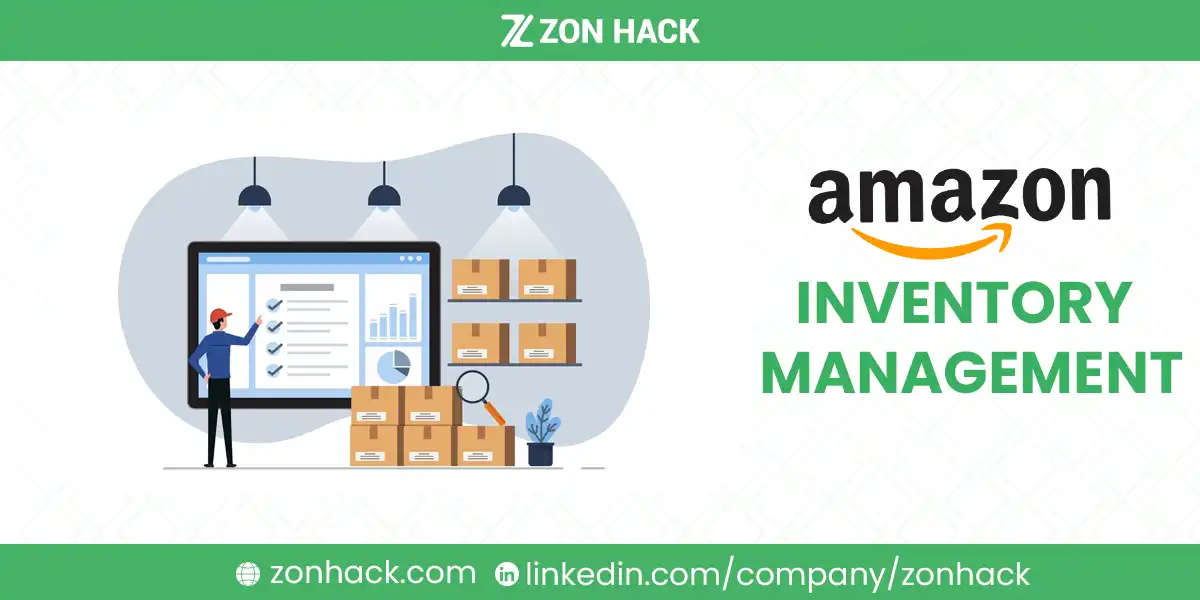Effective inventory management is critical for Amazon sellers to ensure a seamless customer experience, avoid stockouts, and optimize profitability. In this article, we’ll explain the workings of Amazon’s inventory management system, its challenges, tools, best practices, and how sellers can maintain a competitive edge.
What is Amazon Inventory Management?
Amazon inventory management involves tracking products from sourcing, storage, shipping, to processing. For sellers, efficient inventory management is the backbone of profitability and customer satisfaction.
Having an optimized inventory strategy on Amazon impacts:
- Customer Satisfaction: Ensuring products are in stock for quick order fulfillment.
- Sales Optimization: Avoiding missed sales due to stockouts.
- Profitability: Striking a balance to avoid overstocking, which can lead to tied-up capital and storage fees.
- Amazon Ranking: A healthy inventory level boosts your Inventory Performance Index (IPI) score, which in turn affects your storage capacity and associated fees.
Key Takeaway: The importance of Amazon inventory management lies in maintaining a balance between product availability and costs, ensuring optimal customer service and profitability.
What Are the Different Types of Amazon Inventory Management
Understanding the different types of inventory management is crucial for effective operations. Here are some common approaches:
- Just-in-Time (JIT)
This method minimizes inventory holding costs by receiving goods only as they are needed in the production process. It requires strong supplier relationships and accurate demand forecasting.
- ABC Analysis
This technique categorizes inventory into three classes based on their importance:
- A: High-value items with low frequency of sales.
- B: Moderate value and moderate sales frequency.
- C: Low-value items with high sales frequency. This helps prioritize inventory management efforts.
- Consignment Inventory
In this model, the seller only pays for inventory after it is sold, which can improve cash flow but requires careful tracking.
- Dropshipping
Sellers fulfill orders directly from suppliers without holding inventory. This model reduces storage costs but can lead to longer shipping times and less control over product quality.
- Multi-Channel Fulfillment
Using FBA and FBM together, sellers can manage inventory across multiple platforms while optimizing shipping and fulfillment.
Step-by-Step Guide to Effective Amazon Inventory Management
To manage your Amazon inventory effectively, follow these steps:
- Analyze Sales Data: Regularly review sales trends to forecast demand. Utilize tools like Amazon Seller Central and third-party analytics software to identify best-selling products.
- Set Reorder Points: Determine the optimal reorder point for each product based on sales velocity and lead times. Establish minimum stock levels to prevent stockouts.
- Monitor Inventory Levels: Continuously track stock levels using inventory management tools or spreadsheets. Regular audits will help identify discrepancies.
- Optimize Stock Levels: Aim for a balance of around 60 days of supply to prevent both stockouts and overstocking. Adjust orders based on current sales trends.
- Manage Returns: Develop a process for handling returns efficiently, ensuring that returned items are restocked quickly to minimize losses.
- Plan for Seasonal Changes: Use historical sales data to anticipate demand fluctuations during peak seasons and adjust inventory levels accordingly.
- Communicate with Suppliers: Maintain open lines of communication with your suppliers to ensure timely replenishment of stock.
Following a systematic approach to inventory management can lead to increased efficiency and profitability.
What Are the Challenges of Amazon Inventory Management
Inventory management on Amazon comes with its own set of challenges that sellers must navigate carefully.
Running Out of Stock
Stockouts lead to lost sales and give your competitors an advantage. If you’re out of stock, you lose your ranking in Amazon search results, impacting future sales even when the stock is replenished.
Overstocking
On the other hand, holding too much inventory can be just as damaging. Overstocking increases storage fees, particularly with Fulfillment by Amazon (FBA), and ties up capital that could be used elsewhere in the business.
Stranded Inventory
Stranded inventory occurs when products in Amazon’s warehouses are not linked to an active listing. This inventory cannot be sold, yet it continues to incur storage fees.
Spoilage/Expiration
For products with expiration dates (e.g., food, cosmetics), inventory management becomes even more complex, as you must ensure items are sold before they become unsaleable.
Aged Inventory Surcharge
Amazon levies long-term storage fees for inventory stored for over 271 days. This surcharge can eat into your profits, making it crucial to maintain a healthy turnover rate.
Low-Level Inventory Fee
Introduced in 2024, this fee penalizes sellers for consistently low stock levels compared to demand. It can affect shipping speeds and delivery costs, thus harming customer satisfaction.
Avoiding these challenges requires a proactive approach to inventory management, with close attention paid to stock levels, sell-through rates, and the overall health of your inventory.
How to Overcome Amazon Inventory Management Challenges
To navigate the challenges of inventory management on Amazon, consider the following strategies:
- Implement Demand Forecasting: Use historical sales data and market trends to accurately predict future demand, reducing the risk of stockouts and overstocking.
- Set Safety Stock Levels: Maintain a buffer stock for high-demand products to prevent stockouts during unexpected surges in demand.
- Utilize Automation Tools: Leverage inventory management software to automate tracking, reordering, and reporting processes, minimizing human error.
- Conduct Regular Inventory Audits: Frequent audits can help identify issues such as overstock or stranded inventory before they escalate into significant problems.
- Optimize Listings and Promotions: Increase visibility and sales of slow-moving inventory through strategic promotions, discounts, or enhanced listing optimization.
Using Amazon’s Inventory Management Tools for Effective Management
Amazon offers several built-in tools to help sellers optimize their inventory. The FBA Inventory Performance Tool helps sellers manage excess inventory, stranded inventory, and long-term storage fees by providing actionable insights. The Fix Stranded Inventory Tool enables sellers to quickly identify and resolve issues with unsellable stock.
Sellers can also use the FBA Capacity Manager to monitor their monthly storage limits and request additional space if needed. The Inventory Performance Dashboard tracks key metrics such as the sell-through rate and sends alerts when stock levels run low. Central to this system is the Inventory Performance Index (IPI), which measures how efficiently a seller manages their inventory. A higher IPI score allows for greater storage capacity and lower fees.
Which Third-Party Software & Services You Can Use For Better Inventory Management
In addition to Amazon’s tools, there are several third-party software solutions that can enhance a seller’s inventory management system. Popular options include Skubana, SoStocked, Linnworks, Sellbrite, and Veeqo. These tools automate tasks such as restocking, order fulfillment, and inventory tracking. They also provide insights through analytics, allowing sellers to make data-driven decisions.
ZonHack’s Turnkey Amazon FBA & Dropshipping
ZonHack’s Turnkey Amazon FBA & Dropshipping Service is the ultimate solution for sellers looking to streamline their eCommerce business with minimal effort. By handling everything from product sourcing, listing optimization, inventory management, to shipping logistics, ZonHack provides a hassle-free, end-to-end service that allows sellers to focus on growing their business. With years of expertise in Amazon FBA and dropshipping, ZonHack ensures seamless integration with Amazon’s platform, keeping products in stock, reducing storage fees, and maximizing sales potential. Sellers benefit from automated processes and expert management, giving them a competitive edge in the fast-paced world of Amazon selling.
Jungle Scout’s Inventory Manager
Jungle Scout’s Inventory Manager is designed to predict inventory needs and reorder points. It categorizes inventory into statuses like “Reorder Now,” “Reorder Soon,” “Overstock,” and “In Stock,” providing valuable insights for making timely decisions.
Fulfillment by Amazon (FBA) vs. Fulfilled by Merchant (FBM)
Sellers can choose between outsourcing fulfillment to Amazon through FBA, or handling fulfillment themselves via FBM. FBA offers the convenience of Amazon handling storage, shipping, and customer service, but it comes with storage fees. FBM allows more control over fulfillment but requires additional resources.
Multi-Channel Fulfillment (MCF)
Using Multi-Channel Fulfillment (MCF), sellers can fulfill orders from other sales channels using their FBA inventory. This strategy helps streamline inventory management across multiple platforms.
Supply Chain by Amazon
Amazon offers Supply Chain by Amazon, a comprehensive service that helps sellers manage the entire supply chain from production to fulfillment, reducing logistical complexity.
Best Practices for Effective Amazon Inventory Management
Success on Amazon depends on implementing a few best practices for inventory management.
- Regular Inventory Audits
Conduct regular audits to identify discrepancies early. This helps spot potential issues before they affect your inventory performance.
- Centralized Inventory Management System
Using a centralized system to track inventory across all platforms is crucial, particularly for multi-channel sellers. Third-party software can make this process more seamless.
- Strong Supplier Relationships
Open communication with suppliers ensures efficient production and reduces the risk of delays, ensuring a smooth flow of products into your inventory.
- Automated Order Fulfillment
Automation minimizes human error and speeds up the order fulfillment process, ensuring that customers receive their products promptly.
- Efficient Returns Management
Returns can negatively impact profits if not managed efficiently. Reverse logistics ensures returned products are processed and either resold or disposed of with minimal loss.
- Strategic Inventory Reduction
If you have excess inventory, consider running promotions or liquidating stock to avoid storage fees. Keeping inventory levels aligned with demand is key to maintaining profitability.
- Planning for Seasonal Demand Fluctuations
Analyzing past sales data can help anticipate seasonal spikes in demand, allowing sellers to adjust their inventory levels accordingly.
- Adopting Sustainable Practices
Eco-friendly practices such as reducing packaging waste, optimizing shipping, and minimizing unsold stock can help reduce costs and appeal to environmentally conscious consumers.
Bonus: Manual Inventory Management Techniques (For Smaller Sellers)
Smaller sellers who may not have access to sophisticated software can still effectively manage their inventory using manual tracking methods. Spreadsheets or ledgers can be used to track stock, sales, and reorder points. Sellers can apply basic inventory valuation methods such as FIFO (First In, First Out) or LIFO (Last In, First Out) to manage the flow of inventory and calculate stock values.
While manual inventory management is cost-effective, it can be time-consuming and prone to errors, especially as the business scales. For small operations, though, it can serve as a good starting point.
Summary
Optimizing inventory management on Amazon requires a combination of data-driven decision-making, strong supplier relationships, and utilizing the right tools. Regular audits, efficient inventory tracking, and planning for demand fluctuations will help ensure smooth operations. By maintaining optimal stock levels and leveraging Amazon’s tools or third-party software, sellers can improve their profitability, customer satisfaction, and overall business performance.
FAQs
What is the Inventory Performance Index (IPI) on Amazon?
The IPI is a score Amazon uses to measure a seller’s inventory management efficiency. A higher IPI score leads to better storage capacity and reduced fees.
How can I avoid overstocking on Amazon?
You can avoid overstocking by monitoring your sell-through rate, using inventory management tools, and running promotions or liquidation strategies for excess stock.
What are long-term storage fees on Amazon FBA?
Amazon charges long-term storage fees for inventory stored over 271 days. The fee is based on the volume of stored items.
How do I manage inventory across multiple Amazon marketplaces?
You can manage inventory across multiple Amazon marketplaces using Amazon Global Selling, or third-party software like Sellbrite or Skubana for multi-channel fulfillment.




